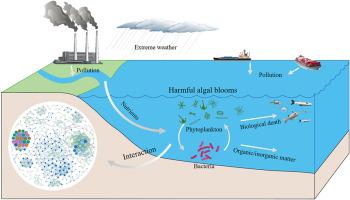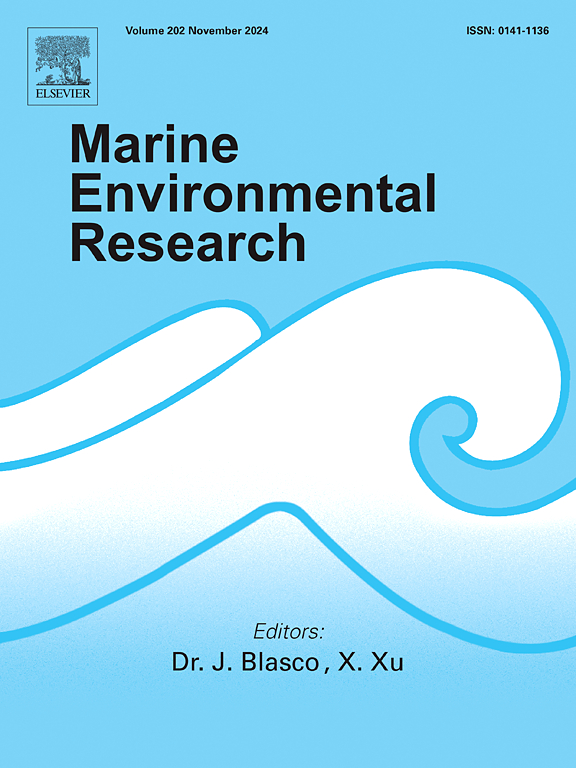渤海湾莱州湾一次非典型冬季藻华微生物群落动态及生态相互作用
IF 3.2
3区 环境科学与生态学
Q2 ENVIRONMENTAL SCIENCES
引用次数: 0
摘要
2021年11月至2022年2月,渤海南部莱州湾发生非典型越冬潮,给养殖业造成重大经济损失。本研究通过夏季、秋季和冬季三次大规模调查和为期一年的对照、华前、华后调查,利用16S和18S rRNA基因高通量测序技术揭示了远洋锦鲤华期间微生物群落的动态变化。我们的研究结果表明,在两次调查中,微生物多样性在藻华期间都有所下降。此外,各阶段微生物群落间存在显著差异。在大规模调查中,浮游植物的优势类群由绿藻门和鞭毛藻门转变为硅藻门(主要是绿藻门),冬季出现藻华。Alphaproteobacteria (Rhodobacteraceae和Clade I)和Actinobacteriota(放线菌科和microbacteraceae)是最丰富的细菌类群。在为期一年的调查中,正如预期的那样,绿足藻是开花期间的主要浮游植物群。红杆菌科(Rhodobacteraceae)和拟杆菌科(Bacteroidota,即黄杆菌科)是花高峰期的优势菌群,而微细菌科(microbacteraceae)则随着花的减少而逐渐丰富。多种环境因素(温度、盐度和养分)对微生物群落有显著影响。此外,共现网络分析揭示了藻华期间微生物群落之间的正相关关系。微生物预测功能主要包括光养、化学异养和氮硫代谢,且在不同阶段变化显著。总体而言,本研究进一步揭示了藻华期间微生物群落的相互作用机制和生态效应。本文章由计算机程序翻译,如有差异,请以英文原文为准。

Microbial community dynamics and ecological interactions during an atypical winter Cerataulina pelagica (Bacillariophyta) bloom in Laizhou Bay, southern Bohai Sea
An atypical winter Cerataulina pelagica bloom outbroke in Laizhou Bay (LZB), southern Bohai Sea during Nov. 2021 and Feb. 2022, which caused a significant economic loss of aquaculture industry. Here, we conducted three large-scale cruise surveys (summer, autumn, and winter) and a one-year surveys (control, pre-bloom, bloom, and post-bloom) in LZB, and used 16S and 18S rRNA genes high-throughput sequencing techniques to reveal the dynamics of microbial communities during the C. pelagica blooms. Our results showed that microbial diversity decreased during algal blooms in both surveys. In addition, there were significant differences between microbial communities at each stage. In the large-scale surveys, the dominant phytoplankton groups changed from Chlorophyta and Dinoflagellate to Bacillariophyta (mainly Cerataulina) with the occurrence of algal blooms in winter. Alphaproteobacteria (Rhodobacteraceae and Clade I) and Actinobacteriota (Actinomarinaceae and Microbacteriaceae) were the most abundant bacterial taxa. In the one-year surveys, Cerataulina were, as expected, the dominant phytoplankton group during the bloom period. Rhodobacteraceae and Bacteroidota (Flavobacteriaceae) were the dominant bacterial groups during the peak period of blooms, whereas Microbacteriaceae gradually enriched with the decline of blooms. A variety of environmental factors (temperature, salinity, and nutrients) had significant effects on microbial communities. In addition, co-occurrence network analysis revealed positive relationships within microbial communities during algal blooms. The microbial prediction function mainly included phototrophy, chemoheterotrophy, and nitrogen and sulfur metabolisms, and there were significant changes in different stages. Overall, this study further reveals the interaction mechanisms and ecological effects of microbial communities during algal blooms.
求助全文
通过发布文献求助,成功后即可免费获取论文全文。
去求助
来源期刊

Marine environmental research
环境科学-毒理学
CiteScore
5.90
自引率
3.00%
发文量
217
审稿时长
46 days
期刊介绍:
Marine Environmental Research publishes original research papers on chemical, physical, and biological interactions in the oceans and coastal waters. The journal serves as a forum for new information on biology, chemistry, and toxicology and syntheses that advance understanding of marine environmental processes.
Submission of multidisciplinary studies is encouraged. Studies that utilize experimental approaches to clarify the roles of anthropogenic and natural causes of changes in marine ecosystems are especially welcome, as are those studies that represent new developments of a theoretical or conceptual aspect of marine science. All papers published in this journal are reviewed by qualified peers prior to acceptance and publication. Examples of topics considered to be appropriate for the journal include, but are not limited to, the following:
– The extent, persistence, and consequences of change and the recovery from such change in natural marine systems
– The biochemical, physiological, and ecological consequences of contaminants to marine organisms and ecosystems
– The biogeochemistry of naturally occurring and anthropogenic substances
– Models that describe and predict the above processes
– Monitoring studies, to the extent that their results provide new information on functional processes
– Methodological papers describing improved quantitative techniques for the marine sciences.
 求助内容:
求助内容: 应助结果提醒方式:
应助结果提醒方式:


